Look and Feel
Model Suitability (out of 10):
Attributes (out of 10):
There are some benefits for having a Japanese speaking editor. When Jason Ku stayed in Japan for a year, he opened a gateway for me to some incredible Japanese papers. This article, as well as the next five, are dedicated to those papers.
We start with a unique, iridescent paper. Its name, as far as we know, has no real meaning, and it may come from the word "Karape" (カラペ - Ka Ra Pe) which is a shortening of the English term "Color Wrapping Paper". Rapisu has no meaning, but it does roll nicely on your tongue.
It is made and distributed by Takeo, a Japanese producer (with more than 5000 papers in its catalogue!), and packed by Toyo, marked as an origami paper. By the way, on the Takeo site it is referred to as a gift wrapping paper.
It is not good for everything, as it sits in the middle of the low weight group. It is mainly for complex and multi-layered models, so do not look for modulars or simple folding in this article. We were unable to get any official data, so it is all based on our tests.
Properties
- Thickness: The paper weighs 42gsm and has a thickness of 71 microns. This puts it in the same category as Unryu, thin Kraft and Onion Skin paper. Unlike the other mentioned papers, it is the only one that is sold as origami paper.
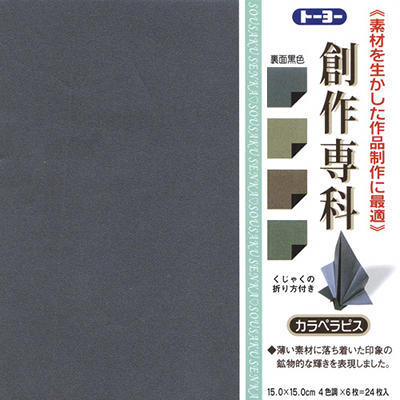 A pack of Karaperapisu
A pack of Karaperapisu - Sizes: There's a complete range of sizes - you can find full sheets at 93.9cm × 63.6cm, or pre-cut squares with a side length of 60cm, 40cm, 30.5cm, or 15cm.
- Colors: 4 colors are available: blue, gold, red, and green.
- Paper Coloring or Colorability: This paper is not meant for coloring.
- Texture: One side is black (!), the other has a shiny, glimmering metal finish. The paper is very smooth on both sides.
- Photogenic: This is a little tricky. The deep colors and the metallic, glimmering texture have great potential. Both the color side and the black reverse have a glimmer that can be a big problem if you do not know how to control your light. It takes a good photographer to bring out its beauty.
- Aging and Wear and Tear: The paper is weak, almost the weakest paper we have tested - it scored 216/316 in the tear machine, while 40gsm Kraft scored 204/247. The paper tore for two of the three of us while folding. 3 out of 10.
- Memory: The paper's performance here surprised us. Although the paper is thin, it has great memory. Once you fold it you need to smooth it strongly to flatten the paper again. 9 out of 10.
- Forgiveness: If you make a sharp crease, you can easily reverse it. You can feel the crease and follow it, just work a little slower than usual. 8 out of 10.
- Tensile Strength: We refer here to the maximum stress the paper can undergo while being stretched or pulled. On the one hand, the paper is flexible and stretched by 11.7mm before snapping! On the other hand, it can hold only 4kg with the grain, and 2kg against the grain. 4 out of 10.
- Bending Resistance: This section rates the amount of force you need to apply to get a sharp crease and how strong the paper is while being curved. Since the test machine is in repair, I have no numbers here but a sense of my hand. The medium papers are highly resistant when folded. A bone folder is almost a must. 9 out of 10. The super thin papers are more welcoming, but they are far from being soft, even given their low weight. 7 out of 10.
- Price group: Expensive - think thoroughly before using – for a best friend's wedding gift.
- Where to buy:
- origami-shop.com (15cm, 30.5cm, 40cm, 60cm)
- OrigamiUSA's TheSource (15cm)
- origami-papier.eu (15cm)
- origamihouse.jp (15cm)
- takeopaper.com (93.9cm × 63.6cm, delivery within Japan only)
Test results
Tessellation
Pineapple tessellation (the extreme version) by Ilan Garibi, 30.5×30.5cm
The extreme version is based on an 8×8 molecule (unlike the 6×6 in the original) and an extra stage in the collapse. This version asks for a thin, very thin paper, but with agility and resistance. Karaperapisu is such a thin paper, and yet the first folds reveal that the paper breaks and takes creases like a much ticker paper. I folded a 34 by 34 grid and could reverse it with only little effort. Only rarely do I miss the existing crease line. I work slowly, sometimes even very slowly, while doing the precreasing. The diagonal folds do not jump into corners, and you have to lead them slowly to place. The black side has very little bump and it is hard to see the crease lines. The collapse is done in three stages, and this is where this paper rocks! It is so thin, yet highly responsive, keeps its shape even when there are many layers, and the paper stay crisp even after a lot of handling.
Complex
Owl by Katsuta Kyohei, 30.5×30.5cm
I could fold the model with this paper very quickly - perhaps my fastest fold of it yet. The paper snaps into place accurately. It was easy to fold the grid as well as all the precreases accurately, and collapsing the base was easier than ever. The paper folds beautifully, and reverses with no effort at all. Truth be told, the talons are usually a big problem, but not this time. Throughout all the open sinks, the paper behaved perfectly. I used tweezers for the final details and the result is highly satisfying.
Lyrebird by Satoshi Kamiya, 30.5×30.5cm
This is the first time I folded the lyrebird. There are many box-pleating moves here and for the first time the paper is a little disappointing. When I fold two to four layers together, I lose accuracy. Inner pleats are much harder to reverse, as required when open sinking back and forth. While pulling aside a layer to reverse it, the paper tore. Another tear formed when I opened the many layers of the wing base. On the plus side, the series of outside-inside reverse folds to create the tail went really well. There is a total of 16 layers of paper, and only few paper types allow manipulating so many layers this easily. To complete the tail, you have to fold a corrugation. I had a lot of issues here. Using the method suggested in the book, it was almost impossible to pull out the wanted layer and to push it back, because of the little tensile strength this paper has. I then tried folding it like a tessellation, but the creases I formed by folding all layers at the same time didn't give me accurate enough crease lines to work with. It was a complete mess. Indeed, this model has steps that you can only easily complete with thin paper, and then other steps where you need some stiffness - which this paper lacks.
3D models
Wizard by Satoshi Kamiya, 30.5×30.5cm
Precreasing went perfectly. The paper has great memory and it was easy to make the long fold lines the first steps. I managed to shape the model as I wanted, and the paper held the shape without MC or other help. Surprisingly, even though the stick has many layers, I managed to get it right, too.
Dwarf by Eric Joisel, 30.5×30.5cm
The paper folds well; I liked the way it reverses and holds the creases and shape. Yes, it is a thin paper, but not thin enough for this model. The hands have so many layers - too many to shape them as I wanted to. Another issue was the weakness - when pulling the paper aside, it easily tears, so I had to work slowly while shaping the beard.
Our young expert
At the age of fourteen, Ynon Toledano is our special third opinion reviewer.
Cicada Nymph and Cyclommatus Metallifer, both by Satoshi Kamiya, 30.5×30.5cm
The paper folds great. It is easy to reverse fold lines, and with both models, the many layers were no obstacle for me. It is good for shaping as well, and I managed to create all small details of the legs. It did tend to break and tear at the edges, and I use just a little MC enforcement at the final stages. All in all it’s a perfect paper for insects, and I really enjoyed it.
Final verdict
While we had hugely varying opinions in our previous review, we had a complete wall to wall approval here - it is a great paper, especially for complex and 3D models. Even for tessellations it worked fine, thanks to the contrast very few papers can achieve: only 0.071mm thick, and yet it can hold a crease perfectly.
However, it is not a perfect paper. There is a price to pay here – the paper is weak and will tear if not handled carefully, as it happened to us. Moreover, its texture and the black reverse - although rare and unique - create a problem: you cannot color it and not that many models are suitable for the iridescent look.
In flickr, I found no pictures of models made from it. It is probably because it is not a well known paper. With more and more online stores starting to sell it, I believe this will change soon.
Why should you buy it?
It is thin, unique in color, and has perfect memory. If you like to fold bugs or complex models, this is the paper for you.
Bottom line: a treasure to be found!

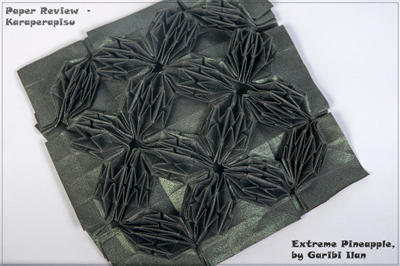
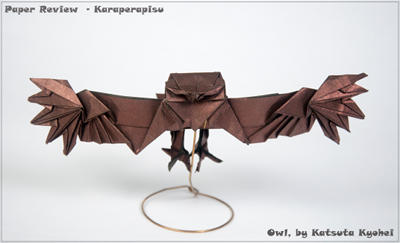
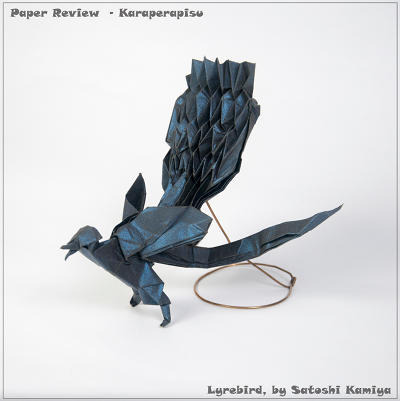
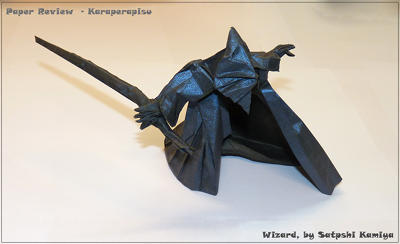
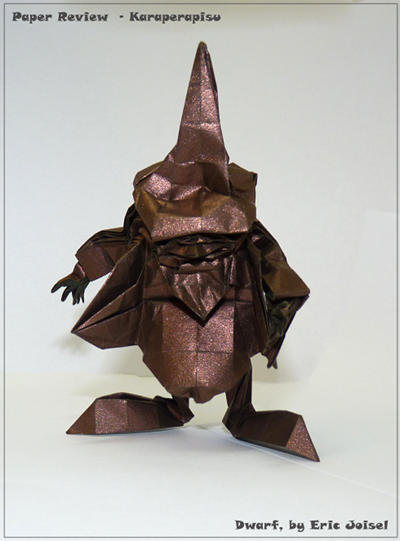
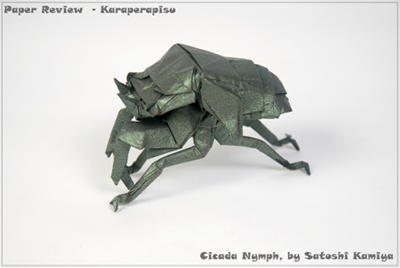
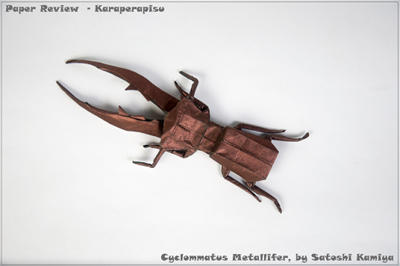
Comments
Submitted by Ella (not verified) on 7 March 2015 - 4:47pm Permalink
Modulars
I folded a modular from this paper:
https://www.flickr.com/photos/115665376@N07/15174884343/
Even though it's thin, it works for modulars, if you choose a small paper size. Folding units from 15 cm or larger would most likly result in an fragile object, but 5 cm or 3.75 x 7.5 cm as in my examplar work well.
Perhaps that's just me, but I like small modulars and those ask for thin paper. This one is highly suitable for that, iridescent is a plus and DC too, both is nice for many modulars.